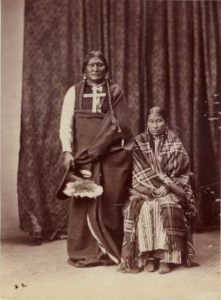Assiniboin Indians
Assiniboin Indians. From a Chippewa term signifying “one who cooks by the use of stones.” E-tans-ke-pa-se-qua, Hidatsa name, from a word signifying “long arrows” (Long, 1823). Guerriers de pierre, French name. Hohe, Dakota name, signifying “rebels.” Sioux of the Rocks, English name. Stonies, or Stone Indians, English name translated from the Indian. Tlu’tlama’eka, Kutenai name, signifying “cutthroats,” the usual term for Dakota derived from the sign language. Weepers, given by Henry (1809). Assiniboin Connections. The Assiniboin belonged to the Siouan linguistic family, and were a branch of the Dakota (see South Dakota), having sprung traditionally from the Yanktonai whose dialect … Read more

